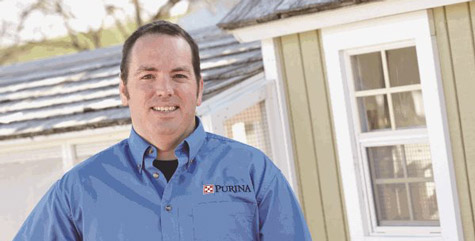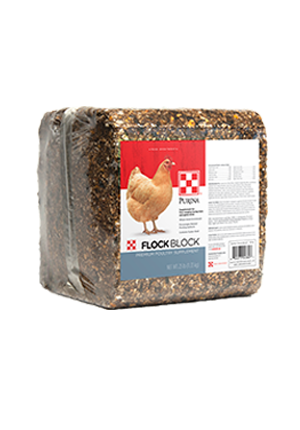
What Do Peacocks Eat? Raising Peacocks, Quail and Other Game Birds
Starting a Flock : Considering Chickens
Flock Management : Layer Nutrition
Raising peacocks, quail, pheasants and other game birds can be a fun addition to a hobby farm or even a small backyard flock. These birds are most often raised for fresh eggs and meat, as well as their colorful feathers and unique companionship. Adult peacocks and game birds thrive best on a high-protein diet, such as Purina® Game Bird Flight Conditioner or Purina® Flock Raiser® feed.
Peafowl, quail, pheasants, guineas and other game birds are a unique option for hobby farms and flock raisers. These birds are raised for many reasons, from meat and eggs to sport and companionship.
If you’re looking to add beauty and variety to your flock through peacocks and game birds, here are a few ideas to start:
Interestingly, peafowl are members of the pheasant family and can live to be 40 to 50 years old. This is much longer than the lifespan of other poultry, so keep this in mind when considering peafowl.
Their vibrant and colorful display of plumage is an amazing conversation piece on any hobby farm or backyard, and their beautiful feathers draw many people to raising peacocks. Peafowl come in a variety of types, including India Blue, Emerald and White peacocks. The pure white albino peacock exists, although they are very rare.
If you are raising peacocks, they need a spacious coop and run (a fenced or enclosed outdoor space). A general rule of thumb is 80 square feet per bird with a pen height of at least 8 feet to fan their feathers. These birds prefer tall roosts to accommodate their tails, which can reach up to 5 feet long. Peafowl can fly high and away into trees, so trimming wing feathers is key if they free range.
Follow this guide for choosing the best peacock feed based on your birds’ ages and stages of life:
Coturnix quail can be raised for both meat and egg production. These birds are excellent feed converters and reach their mature weight of 5 to 6 ounces in just six weeks. Coturnix quail begin laying beautiful, speckled eggs between 7 and 8 weeks of age and can lay 250 to 300 eggs each year.
Like other backyard birds, game bird chicks should spend their first four to six weeks in a brooder and then move to a coop with a run. Providing a large area with places for the birds to find shelter and comfort can promote a happy flock community.
If raising pheasants, these birds do best when provided a flight pen with approximately 20 square feet per bird. Pheasants love gardens in their flight pens where annual grasses, evergreens and perennial plants can provide shelter and promote full feathering.
For example, whether you’re raising quail for meat or sport, feed Purina® Gamebird 30% Protein Starter feed from 0 to 6 weeks of age. For most quail (everything but Coturnix) transition to either Purina® Game Bird Flight Conditioner or Purina® Flock Raiser® feeds as they are very similar in nutrient composition.
If you have Coturnix quail, transition the females to Purina® Game Bird Layer feed at 6 weeks of age. Coturnix quail may begin laying as early as 6 weeks of age. Once the egg-laying season has finished, switch your hens back to Purina® Game Bird Flight Conditioner or Purina® Flock Raiser® feeds. Other quail may start laying eggs around 16 weeks of age; pheasants at 10 months of age; and guinea fowl around 24 weeks of age. Switch to Purina® Game Bird Layer feed when eggs begin to appear. With the exception of Coturnix quail, game birds are seasonal with regards to egg production. Most egg production occurs between May and October. Once the birds have stopped laying for the season, return them to Purina® Game Bird Flight Conditioner until the following season.
It is not recommended to feed layer feed to male birds. It is best to keep male birds on Purina® Game Bird Flight Conditioner feed while the females are offered Purina® Game Bird Layer feed. Feeding the males and females separate feeds can be challenging. One option to feed both is to keep everyone on Purina® Game Bird Flight Conditioner feed and place a separate feeder with Purina® Oyster Shell for the hens to get the extra calcium they need for eggshell production.
If your game birds are putting on extra weight in the off season, consider switching to Purina® Game Bird Maintenance feed. Its lower protein and energy help keep birds in shape as their feed intake increases during cooler weather. As the weather begins to warm and the hens prepare to start laying eggs again, transition hens back to a layer feed and the males back to Purina® Game Bird Flight Conditioner or Purina® Flock Raiser® feeds.
Ready to add peafowl or game birds to your flock? Visit your local Purina® retailer to pick up everything you need to get started.
Peafowl, quail, pheasants, guineas and other game birds are a unique option for hobby farms and flock raisers. These birds are raised for many reasons, from meat and eggs to sport and companionship.
If you’re looking to add beauty and variety to your flock through peacocks and game birds, here are a few ideas to start:
Raising peacocks
Raising peacocks or peafowl may seem exotic but they’re a great and relatively easy option for hobby farms and backyards. Peafowl is the generic term for both male peacocks and female peahens.Interestingly, peafowl are members of the pheasant family and can live to be 40 to 50 years old. This is much longer than the lifespan of other poultry, so keep this in mind when considering peafowl.
Their vibrant and colorful display of plumage is an amazing conversation piece on any hobby farm or backyard, and their beautiful feathers draw many people to raising peacocks. Peafowl come in a variety of types, including India Blue, Emerald and White peacocks. The pure white albino peacock exists, although they are very rare.
If you are raising peacocks, they need a spacious coop and run (a fenced or enclosed outdoor space). A general rule of thumb is 80 square feet per bird with a pen height of at least 8 feet to fan their feathers. These birds prefer tall roosts to accommodate their tails, which can reach up to 5 feet long. Peafowl can fly high and away into trees, so trimming wing feathers is key if they free range.
What do peacocks eat?
Peafowl need a high level of protein to maintain their beautiful feathers. A peacock feather is made of 90 percent protein, so it’s important to provide essential amino acids with a complete feed.Follow this guide for choosing the best peacock feed based on your birds’ ages and stages of life:
- From hatch to 6 weeks of age, peafowl chicks should be fed Purina® Game Bird 30% Protein Starter feed.
- After 6 weeks, switch to Purina® Game Bird Flight Conditioner feed or Purina® Flock Raiser® feed for mixed-species flocks.
- If peahens are laying eggs, provide them a complete layer feed for extra calcium, such as Purina® Game Bird Layer® feed.
- Once the laying season has ended, switch peahens back to Purina® Game Bird Flight Conditioner or Purina® Flock Raiser® feeds.
Raising quail and other game birds
Quail, pheasants, guineas and jungle fowl all fall into the game bird category. If you’re thinking about raising quail, consider Coturnix quail. They don’t require much space and can be very social.Coturnix quail can be raised for both meat and egg production. These birds are excellent feed converters and reach their mature weight of 5 to 6 ounces in just six weeks. Coturnix quail begin laying beautiful, speckled eggs between 7 and 8 weeks of age and can lay 250 to 300 eggs each year.
Like other backyard birds, game bird chicks should spend their first four to six weeks in a brooder and then move to a coop with a run. Providing a large area with places for the birds to find shelter and comfort can promote a happy flock community.
If raising pheasants, these birds do best when provided a flight pen with approximately 20 square feet per bird. Pheasants love gardens in their flight pens where annual grasses, evergreens and perennial plants can provide shelter and promote full feathering.
What do pheasants, quail and guinea fowl eat?
You can follow a similar feeding program for all these game birds. Because they have unique nutritional requirements compared to other flock species, choose a complete feed formulated just for game birds.For example, whether you’re raising quail for meat or sport, feed Purina® Gamebird 30% Protein Starter feed from 0 to 6 weeks of age. For most quail (everything but Coturnix) transition to either Purina® Game Bird Flight Conditioner or Purina® Flock Raiser® feeds as they are very similar in nutrient composition.
If you have Coturnix quail, transition the females to Purina® Game Bird Layer feed at 6 weeks of age. Coturnix quail may begin laying as early as 6 weeks of age. Once the egg-laying season has finished, switch your hens back to Purina® Game Bird Flight Conditioner or Purina® Flock Raiser® feeds. Other quail may start laying eggs around 16 weeks of age; pheasants at 10 months of age; and guinea fowl around 24 weeks of age. Switch to Purina® Game Bird Layer feed when eggs begin to appear. With the exception of Coturnix quail, game birds are seasonal with regards to egg production. Most egg production occurs between May and October. Once the birds have stopped laying for the season, return them to Purina® Game Bird Flight Conditioner until the following season.
It is not recommended to feed layer feed to male birds. It is best to keep male birds on Purina® Game Bird Flight Conditioner feed while the females are offered Purina® Game Bird Layer feed. Feeding the males and females separate feeds can be challenging. One option to feed both is to keep everyone on Purina® Game Bird Flight Conditioner feed and place a separate feeder with Purina® Oyster Shell for the hens to get the extra calcium they need for eggshell production.
If your game birds are putting on extra weight in the off season, consider switching to Purina® Game Bird Maintenance feed. Its lower protein and energy help keep birds in shape as their feed intake increases during cooler weather. As the weather begins to warm and the hens prepare to start laying eggs again, transition hens back to a layer feed and the males back to Purina® Game Bird Flight Conditioner or Purina® Flock Raiser® feeds.
Ready to add peafowl or game birds to your flock? Visit your local Purina® retailer to pick up everything you need to get started.





